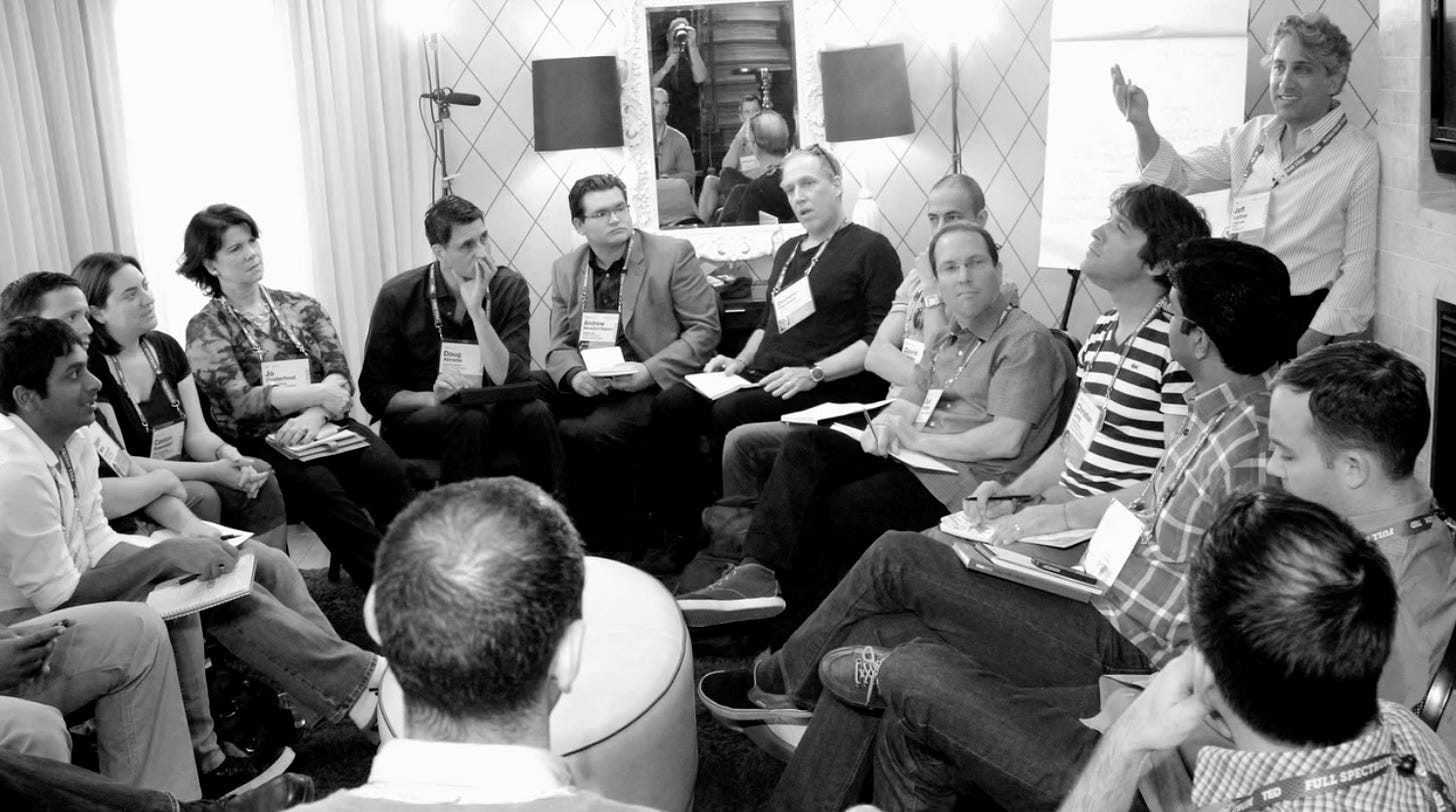TED, teams, and transcendent interest
Helping professionals need bigger goals for authentic collaboration. The good news is we know where to find them.
Just about every helping professional — but especially those who spend any time inside a hospital — has been lectured on the importance of interdisciplinary collaboration. Yet most of the time I find teams have not even taken the preliminary steps they’ll need to do great work together.
I’ve been thinking about this issue since at least 2012, when the TED Conferences asked Insight Labs to consider the problem of collaboration at scale. TED was considering how to take the gigantic worldwide network they had built and use it to do more than get people to watch interesting videos. At the time, the problem was framed as one of digital vs. in-person collaboration, with a focus on how to adapt some of the best elements of both into a new framework.
When we packed a group of TED luminaries into a hotel suite in Palm Springs, they called out all sorts of important traits of collaboration. (Here’s some video highlights.) But the one that stuck was the need for the group to collectively discover a transcendent interest.
Before the Lab, we had discussed the need for groups to organize around transcendent goals with Frank Barrett, a researcher into organizational dynamics at the Naval Postgraduate School (he’s now at Case Western). That’s the proverbial hill the troops can only take together. As my colleague Jeff Leitner put it, “If the goal is not larger than our individual interests, it is not collaboration.”
But the Lab discovered that transcendent interest is something more visceral and more intuitive. As team members get to know each other, they discover that there are more important goals than the ones that initially brought them together. The skills that are most relevant to the collaboration are not the ones they imagined. The endpoint of the collaboration is not anything like what they had dreamed. Allowing for this kind of emergence requires vulnerability, white space, and the freedom to make mistakes.
This almost never happens in healthcare settings — or at least, it almost never happens in the settings that bear the interdisciplinary label. The groups most likely to have experienced something like it are teams who have worked together a long time, cultivated a high degree of trust, and pushed against problems none of them could have solved on their own — think the best NICU or cancer ward you’ve ever seen.
(And it sometimes emerged during the pandemic, for those who choose to recall it.)
In “interdisciplinary” settings, though, the various professions almost always stick to their corners. Frequently the putative teams are just panels or conferences with no shared goal at all, just talk. There is frequent evocation of the various members’ expertise and professional training, as well as effusive praise for the effort to bring all these perspectives together. You won’t hear that in a jazz combo or a champion sports team or a group of coders the night before a product launch.
One might say, so what? Do we really need the physicians and the nurses and the pharmacists and the dentists and the social workers to become best friends? Actually the future of American health might depend on it.
In 2016 I asked experts from a range of fields how professionals can tackle the social determinants of health — the single greatest cause of our country’s dismal life expectancy statistics. One of the most consistent themes was the need to organize care teams around populations’ social needs, ideally starting during their professional education. This isn’t just about skills and it isn’t just about expertise, though both of those are sorely lacking. It’s about building up the muscle memory of team formation around goals bigger than any one team member or their professional discipline.
The good news is that nearly every problem in population health provides this opportunity for transcendence. As any undergraduate student in a health policy course will tell you, our current system of care is built around expensive treatments for disease rather than low-cost interventions to preserve health. We pay to amputate limbs, not to prevent diabetes — and nothing will change until we discard that mindset.
But once we have, the opportunities to address health challenges are incredibly open-ended. Problems like social exclusion, childhood trauma, and structural racism have many sources and many potential cures. This affords communities (and embedded care teams) the chance to discover the most actionable opportunities together. It’s the pediatric clinic that decides to take on lead abatement, or the town that starts out trying to prevent asthma and ends up building soccer fields (an example illuminated by this interview with Christopher Holliday, now with the CDC).
I’m excited to address those problems, but I’m even more excited for the way they can transform teams. Nurses and social workers and physicians aren’t just nurses and social workers and physicians. They are all helpers and healers before they put on any of those professional masks. Every person I know who works in care has a desire to rediscover that deeper identity. It’s time to connect them with the community challenges that will actually help them do it.


